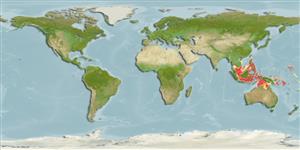>
Stomiiformes (Lightfishes and dragonfishes) >
Sternoptychidae (Marine hatchetfishes) > Sternoptychinae
Etymology: Polyipnus: Greek, poly = a lot of + Greek, ipnos = lanterns.
More on author: Günther.
Environment: milieu / climate zone / depth range / distribution range
Écologie
marin benthopélagique; profondeur 0 - 500 m (Ref. 74511). Deep-water
Western Cental Pacific: Celebes and Halmahera seas and the Philippines. South China Sea, East China Sea, and the water near Taiwan (Ref.74511).
Taille / Poids / Âge
Maturity: Lm ? range ? - ? cm
Max length : 8.5 cm SL mâle / non sexé; (Ref. 26382)
Description synthétique
Clés d'identification | Morphologie | Morphométrie
Rayons mous dorsaux (Total) : 12 - 14; Rayons mous anaux: 15 - 17.
Found on the continental shelf (Ref. 75154).
Life cycle and mating behavior
Maturité | Reproduction | Frai | Œufs | Fécondité | Larves
Harold, A.S., 1994. A taxonomic revision of the sternoptychid genus Polyipnus (Teleostei: Stomiiformes) with an analysis of phylogenetic relationships. Bull. Mar. Sci. 54(2):428-534. (Ref. 26382)
Statut dans la liste rouge de l'IUCN (Ref. 130435: Version 2024-1)
Menace pour l'homme
Harmless
Utilisations par l'homme
Outils
Articles particuliers
Télécharger en XML
Sources Internet
Estimates based on models
Preferred temperature (Ref.
123201): 14.8 - 27.4, mean 21.5 °C (based on 115 cells).
Phylogenetic diversity index (Ref.
82804): PD
50 = 0.5000 [Uniqueness, from 0.5 = low to 2.0 = high].
Bayesian length-weight: a=0.02291 (0.01031 - 0.05092), b=2.94 (2.74 - 3.14), in cm total length, based on LWR estimates for this (Sub)family-body shape (Ref.
93245).
Niveau trophique (Ref.
69278): 3.3 ±0.3 se; based on size and trophs of closest relatives
Résilience (Ref.
120179): Haut, temps minimum de doublement de population inférieur à 15 mois (Preliminary K or Fecundity.).
Fishing Vulnerability (Ref.
59153): Low vulnerability (10 of 100).
